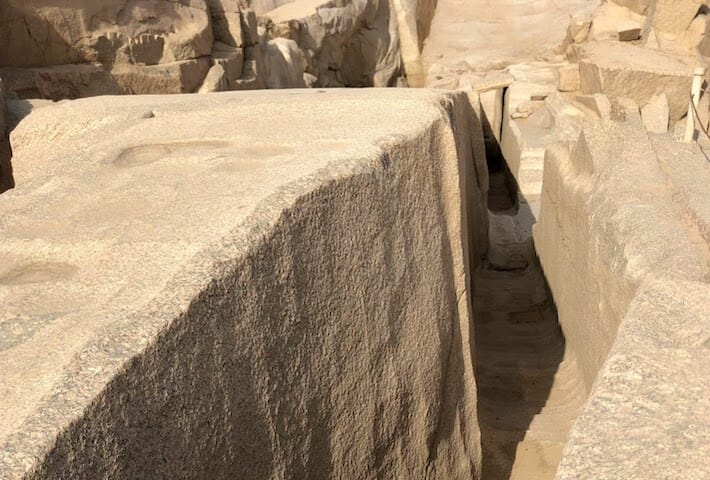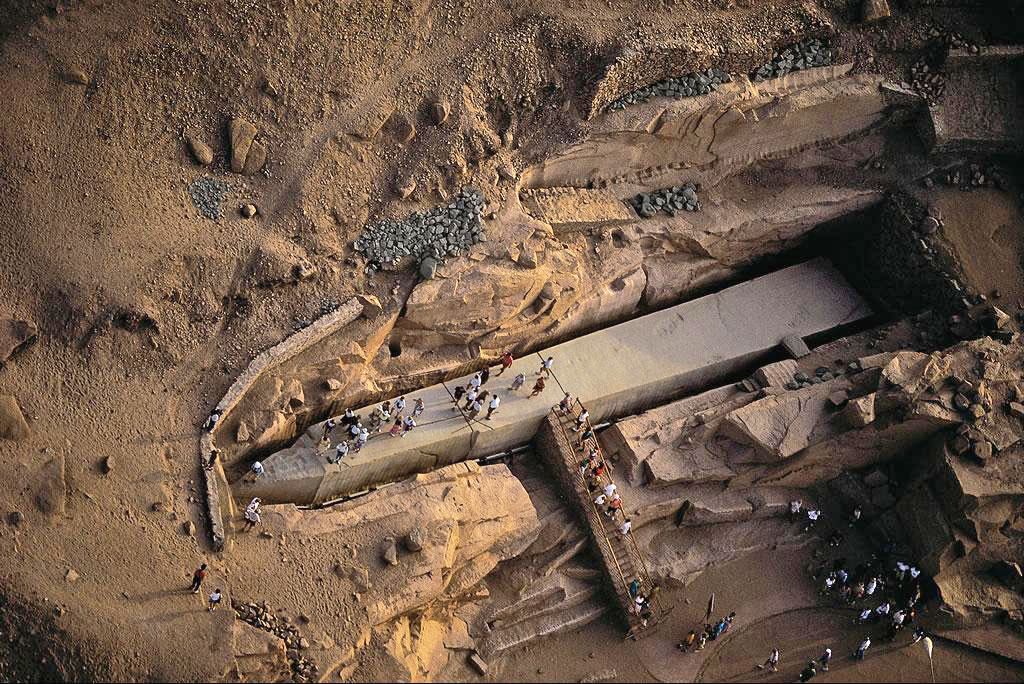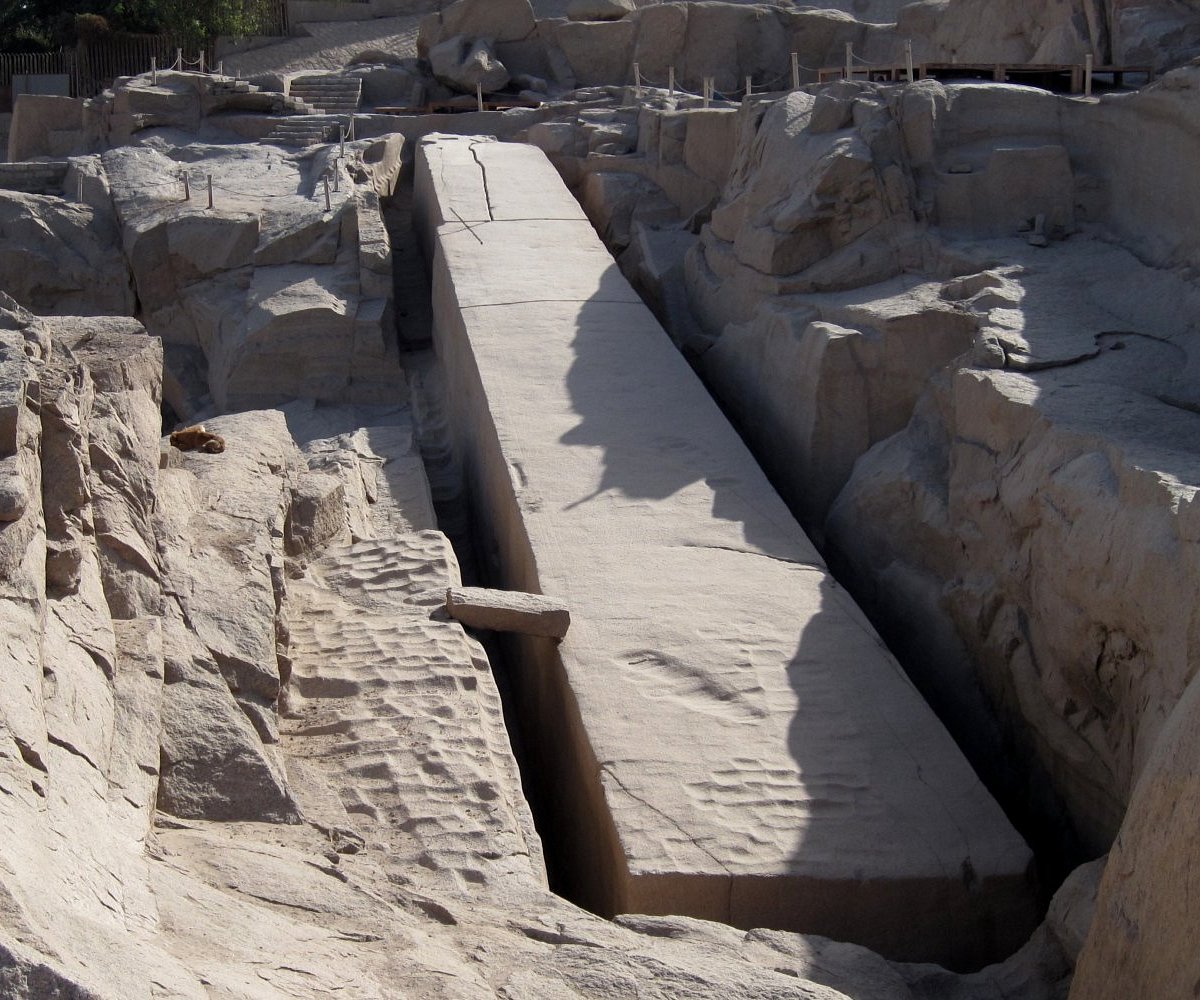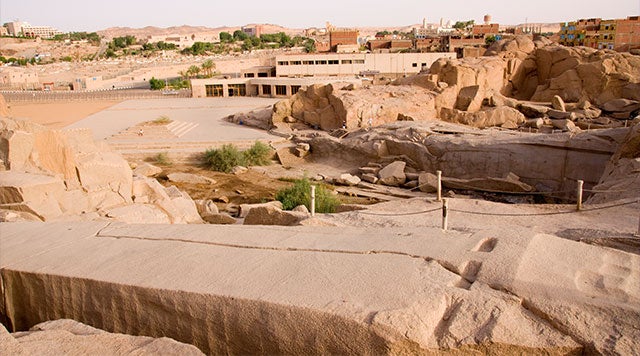The Unfinished Obelisk of Egypt: A History and Guide
Egypt has always been a country of mysteries and wonders, with its rich history and archaeological finds. However, one monument stands incomplete today, known as the Unfinished Obelisk. This fascinating structure is located in Aswan, Egypt and has a captivating story behind it. Visitors worldwide flock to this site to understand the history and significance of this incredible monument.
In this article, we'll take a closer look at the Unfinished Obelisk of Egypt and its backstory and why it has become a must-see attraction in the country.

Introduction
A brief overview of the Unfinished Obelisk
The Unfinished Obelisk of Egypt is a fascinating piece of ancient history that offers a glimpse into the construction techniques of the ancient Egyptians. It would have been the largest obelisk in the world, standing at 42 metres tall and weighing 1,200 tonnes. However, the construction was abandoned due to the discovery of cracks in the stone.
Despite its unfinished state, the obelisk is still a remarkable sight. It is located in Aswan, Egypt, in a red granite quarry. Visitors can observe the obelisk and learn about the instruments and techniques used by the ancient Egyptians to carve these enormous structures.
The obelisk is believed to have been commissioned by Queen Hatshepsut of the 18th dynasty, and it is designed to resemble the primaeval hill from the myth of creation. Exploring the site and witnessing the sheer magnitude of the obelisk is a truly awe-inspiring experience.
Visiting the Unfinished Obelisk is a must for anyone interested in ancient Egyptian history and the incredible feats of engineering achieved by this ancient civilization.

Importance of the Unfinished Obelisk in Egyptian History
The Unfinished Obelisk holds immense significance in Egyptian history. This granite monument, though incomplete, provides valuable insights into the stone-carving techniques of the ancient Egyptians. The scratches of their tools can still be seen on the rock's surface, indicating their expertise and skill.
Queen Hatshepsut, one of the few female pharaohs in ancient Egypt, was believed to have commissioned its construction during the 18th dynasty. The obelisk was intended to be the tallest and heaviest ever built, measuring 42 metres and weighing 1,200 tonnes. However, the project was abruptly abandoned due to the discovery of cracks in the granite.
The Unfinished Obelisk is a treasure trove of archaeological knowledge. It offers a glimpse into the construction methods employed by the ancient Egyptians. They used dolerite, a mineral harder than granite, as ball bearings to carve through the rocks. Creative techniques, such as creating small cavities filled with water-soaked wood chips, were used to detach the obelisk from its base.
The site where the obelisk is located, in the granite quarry of Aswan, serves as an open-air museum, preserving these remarkable structures for future generations.
Visiting the Unfinished Obelisk allows visitors to appreciate the ingenuity and craftsmanship of the ancient Egyptians. It is a testament to their unwavering dedication to creating monumental structures that still captivate us today. Exploring this historical site is a must for anyone interested in delving deeper into the mysteries of ancient Egypt.

Purpose of the blog
This blog aims to provide readers with a comprehensive history and guide to the Unfinished Obelisk of Egypt. By exploring the origins, significance, and construction techniques of obelisks in ancient Egypt, readers will gain a deep understanding of the Unfinished Obelisk's importance in Egyptian history. The blog aims to showcase the unmatched skill and intelligence of the ancient Egyptians who attempted to create this monumental structure.
Additionally, the blog highlights the discovery and location of the obelisk in Aswan and the reasons why its construction was abandoned. By providing factual data and information, readers will be able to visualize and appreciate the dimensions and measurements of the obelisk. The blog also encourages readers to visit and explore the site, offering information on guided tours and visitor facilities.
With its friendly tone and factual data, this blog aims to engage and educate readers about the intriguing history and significance of the Unfinished Obelisk of Egypt.

Historical Background
Origins of Obelisks in Ancient Egypt
The origins of obelisks in ancient Egypt can be traced back to the New Kingdom period, specifically the 18th dynasty. These towering structures were created to symbolise power and prestige for the pharaohs. Obelisks were typically made from a single block of stone, usually granite, and were carved with intricate hieroglyphic inscriptions.
The obelisk's shape, with its four sides converging to a miniature pyramidal shape at the top, was meant to symbolize the primaeval hill from the creation myth. It was believed that the creator god Atum stood above this mound at the time of creation. Additionally, many scholars believe that obelisks were associated with astronomical events, such as the zodiac lights and sun movement.
The construction of obelisks required great skill and precision. Ancient Egyptians used various techniques, such as carving and shaping the stone with dolerite balls and using wooden wedges soaked in water to detach the obelisk from the bedrock.
Overall, obelisks played a significant role in ancient Egyptian culture and continue to captivate visitors with their grandeur and historical significance.

Significance of Obelisks in Ancient Egyptian Culture
Obelisks were significant in ancient Egyptian culture and important to their religious practices and beliefs. These towering monuments represented the benben, the primordial mound upon which the god Atum stood during the world's creation. They were associated with the benu bird, which was believed to be the first living creature whose cry signalled the beginning of creation.
The obelisks symbolized the vitality and immortality of the pharaohs and the gods they honoured. They also represented balance and duality, with pairs of obelisks raised to honour specific gods or commemorate significant events. The obelisks were carefully positioned to catch the first and last rays of the sun, symbolizing the journey of the sun god Ra and marking the passage of day and night.
While the exact techniques for raising obelisks remain a mystery, their impressive size, shape, and meticulous craftsmanship demonstrate the remarkable skills of the ancient Egyptians. Today, the surviving obelisks are revered as magnificent relics of ancient Egyptian civilization, attracting visitors worldwide. Visiting these monumental structures provides a unique opportunity to delve into Egypt's rich history and cultural heritage.

Construction techniques used in building obelisks
The construction techniques used in building obelisks in ancient Egypt were truly impressive, showcasing the unmatched intelligence and skill of the ancient Egyptians. The Unfinished Obelisk, in particular, provides great evidence for these techniques.
The ancient Egyptians used dolerite, a small ball made of a mineral harder than granite, to carve out the obelisk from the bedrock. They also employed creative building techniques to free the obelisk from the base. They created small cavities in the rock and filled them with wood chips, which were soaked with water. The soaking caused the wood chips to expand, thus detaching the obelisk from the base.
Despite the limited tools and resources, these techniques allowed the ancient Egyptians to create monumental structures like the Unfinished Obelisk. The marks of these tools can still be seen on the obelisk's surface, providing fascinating insights into the construction process.
Exploring the Unfinished Obelisk and other ancient Egyptian attractions is a truly mesmerizing experience that allows visitors to witness the greatness of the Egyptian civilization firsthand.

The Unfinished Obelisk: Discovery and Location
Discovery of the Unfinished Obelisk
The discovery of the Unfinished Obelisk in Aswan, Egypt, is a fascinating tale that provides insight into the ancient Egyptian construction process. This majestic obelisk, which would have been the largest ever constructed, stands as a testament to the intelligence and skill of the ancient Egyptians.
The obelisk was built during the 18th Dynasty by the wife of King Thutmose II, Hatshepsut, to complement the Lateran Obelisk in Karnak. It was designed to resemble the primaeval hill from the creation myth, making it a significant symbol in ancient Egyptian culture.
However, the obelisk construction was abruptly abandoned due to the discovery of numerous cracks in the stone. The sheer size and weight of the obelisk, which would have measured 42 metres and weighed 1,200 tonnes, presented challenges that the ancient Egyptians could not overcome. As a result, the obelisk remains in its original location in a granite quarry in Aswan, attracting tourists worldwide.
Today, visitors can explore the Unfinished Obelisk site and learn about the techniques used by the ancient Egyptians to construct such massive structures. The location is considered an open-air museum, providing a unique glimpse into the instruments and creative building techniques employed during that time. A visit to the Unfinished Obelisk is a truly awe-inspiring experience that allows visitors to appreciate the ingenuity and craftsmanship of the ancient Egyptians.
Location of the Unfinished Obelisk in Aswan
The Unfinished Obelisk is located in the northern region of the stone quarries in Aswan, Egypt. Aswan is a city that is known for its rich historical significance and ancient monuments. The obelisk can be found in an open-air museum, allowing visitors to explore and appreciate its grandeur.
The location itself adds to the allure of the Unfinished Obelisk, as it is situated in the very place where it was carved out of the granite bedrock. This gives visitors a unique opportunity to witness the intricate construction techniques used by ancient Egyptian craftsmen. The site also offers stunning views of the surrounding area, with the Nile River flowing nearby.
Aswan is easily accessible and is a popular tourist destination in Egypt, making it convenient for visitors to explore the Unfinished Obelisk and other nearby attractions. Whether you are a history enthusiast or appreciate the wonders of ancient architecture, a visit to the Unfinished Obelisk in Aswan is a must.

Why the construction of the obelisk was abandoned
The construction of the Unfinished Obelisk was abandoned due to a significant crack that appeared during the carving process. The crack, believed to be caused by a natural flaw in the granite or a miscalculation during the quarrying process, rendered the obelisk unusable for its intended purpose.
The ancient Egyptians, known for their dedication to perfection, abandoned the project rather than continue with a flawed structure. While efforts were made to preserve the obelisk and reduce its size to cut out sections with troublesome fissures, a large crack running right into it made it unsound at its most vulnerable point, the centre. Egyptian engineers could not find a lasting solution for this particular crack, leading to the ultimate decision to abandon the construction.
The story of the Unfinished Obelisk serves as a testament to the challenges faced by the ancient builders and showcases their commitment to quality and precision in their architectural endeavours. Despite being unfinished, the obelisk continues to captivate visitors and offers a unique glimpse into ancient Egypt's construction techniques and ambitions.

Characteristics of the Unfinished Obelisk
Dimensions and measurements of the obelisk
The Unfinished Obelisk, had it been completed, would have been an awe-inspiring sight. This colossal structure was estimated to measure around 41.75 metres (137 feet) in height and weigh approximately 1,168 tonnes. Standing as the largest known ancient obelisk, it would have dwarfed any other obelisk ever erected.
The Unfinished Obelisk's sheer size highlights the ancient Egyptians' ambitious nature and dedication to monumental projects. As you approach the site in Aswan, the massive obelisk lying partially carved and abandoned commands attention. Its dimensions and measurements give you a sense of the colossal scale that the ancient craftsmen were attempting to achieve.
Despite its incomplete state, the Unfinished Obelisk still stands tall at around 42 metres, serving as a reminder of the engineering prowess of the ancient Egyptians. Visiting this remarkable archaeological site allows you to marvel at the size and envision the grandeur it would have achieved if completed.
So, if you are fascinated by ancient Egyptian history and engineering, a trip to the Unfinished Obelisk is a must.

Guided tours and visitor facilities
Guided tours and visitor facilities at the Unfinished Obelisk in Aswan provide an excellent opportunity for travellers to explore this remarkable historical site.
When you visit the site, you can join a guided tour led by experienced Egyptologists who will provide valuable insights into the history and significance of the obelisk. These tours offer a comprehensive overview of the ancient Egyptians' construction techniques and why the obelisk was left unfinished.
In addition to guided tours, visitor facilities are available at the site to enhance your experience. The area surrounding the obelisk has been transformed into an open-air museum, allowing visitors to get a closer look at the tools and techniques used by the ancient Egyptians. The small cavities and wood chips used to detach the obelisk from the bedrock provide a fascinating glimpse into the ancient quarrying process.
Furthermore, there are opportunities to explore the surrounding area, which is rich in ancient Egyptian history and culture. The nearby temple complex at Karnak is a must-visit destination for anyone interested in ancient history, and the city of Aswan offers a vibrant and welcoming atmosphere.
Overall, the Unfinished Obelisk's guided tours and visitor facilities provide travellers with an immersive and educational experience. Whether you are a history enthusiast or simply curious about ancient Egyptian architecture, visiting this site will surely be a memorable and enlightening journey.

Encouragement for readers to visit and explore the site
If you deeply appreciate ancient history and remarkable archaeological sites, visiting the Unfinished Obelisk in Egypt's Aswan region is an absolute must. This majestic marvel of ancient architecture offers a unique glimpse into the ingenuity and skill of the ancient Egyptians.
As the largest known ancient obelisk, the Unfinished Obelisk truly showcases the immense talent of the ancient Egyptians. Standing at a height of 42 metres, it would have been the tallest obelisk in history if it had been completed. Unfortunately, the project was abandoned due to the discovery of cracks in the obelisk. Nevertheless, the unfinished state of the obelisk provides valuable insights into the construction techniques used by the ancient Egyptians.
Visiting the Unfinished Obelisk is like stepping back in time. As you wander through the open-air museum, you will see the tools and methods employed by ancient workers to carve this massive monument out of the bedrock. From using dolerite balls to carve the obelisk to the innovative technique of filling cavities with water-soaked wood chips to detach it from the base, the construction process of the Unfinished Obelisk is fascinating to behold.
Not only will you have the opportunity to marvel at this monumental structure, but the site is also conveniently located near other top attractions, such as the Nubian Museum and Elephantine Island. So, why not plan a visit and immerse yourself in Egypt's rich history and awe-inspiring ancient wonders? A trip to the Unfinished Obelisk will surely be an unforgettable experience that will leave you with a deeper appreciation for the remarkable achievements of the ancient Egyptians.
